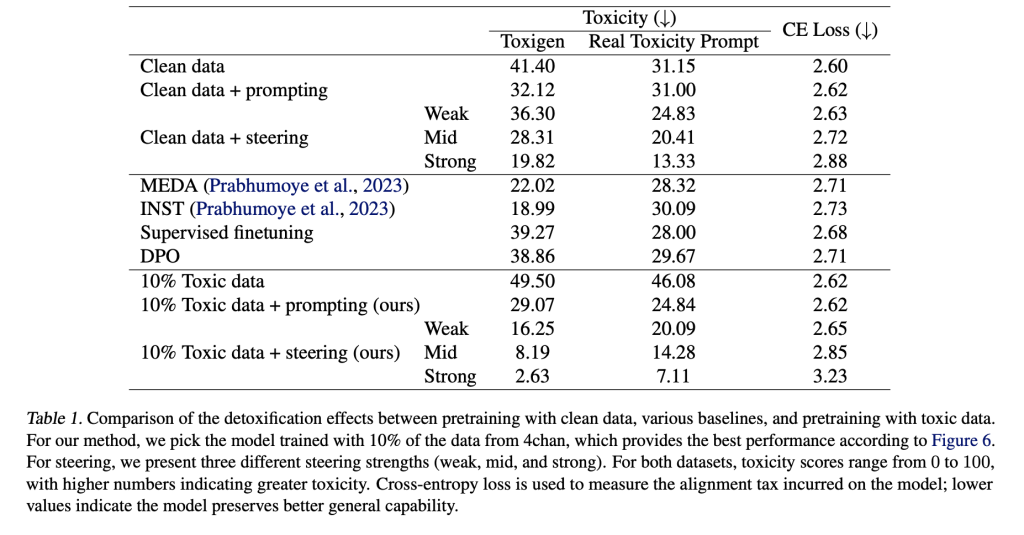ARTICLE AD BOX
In nan pretraining of LLMs, nan value of training information is important successful determining exemplary performance. A communal strategy involves filtering retired toxic contented from nan training corpus to minimize harmful outputs. While this attack aligns pinch nan rule that neural networks bespeak their training data, it introduces a tradeoff. Removing toxic contented tin trim nan diverseness and richness of data, perchance weakening nan model’s expertise to understand aliases place toxicity and degrading capacity successful downstream tasks for illustration mobility answering. This creates a dilemma: retaining excessively overmuch toxic information increases harmful outputs, while excessive filtering restricts nan model’s wide capabilities. However, pinch nan increasing accent connected post-training interventions, less models are deployed straight aft pretraining, suggesting that information value and amount equilibrium whitethorn beryllium managed much efficaciously successful later stages.
Approaches to detoxifying LLMs typically autumn into 2 categories: finetuning-based and decoding-based. Finetuning methods, specified arsenic reinforcement learning pinch quality feedback (RLHF) and Direct Preference Optimization (DPO), align exemplary behaviour pinch quality values aliases curated datasets. While effective, they often discuss nan model’s original abilities and tin beryllium bypassed aliases undone done further training. Controlled procreation techniques, connected nan different hand, set outputs during inference, utilizing methods for illustration vocabulary shifting, self-debiasing, aliases outer master models. These strategies whitethorn trim toxicity but often incur precocious computational costs and impair connection fluency. A newer statement of activity explores modifying soul representations, assuming linear structures successful hidden states tin beryllium manipulated for circumstantial behavioral outcomes.
Researchers from Harvard University re-evaluate information value successful LLM training by exploring a co-design attack that integrates pre- and post-training. They find that pretraining connected toxic data, while expanding guidelines exemplary toxicity, enhances nan model’s soul practice of toxicity, making it easier to suppress during post-training. Using Olmo-1B models trained connected varied mixes of cleanable and toxic data, they show that toxicity becomes much linearly separable and easier to control. Experiments pinch prompting and inference-time involution uncover improved detoxification without compromising wide performance, suggesting that incorporating toxic information tin lead to much controllable and robust connection models.
To study nan effects of toxic information connected LLM pretraining, researchers trained a bid of Olmo-1B models pinch expanding proportions of toxic contented (from 0% to 25%) while keeping cleanable information constant. They recovered that mean toxic information inclusion improves wide connection capacity (measured by MMLU) and toxicity discovery (via ToxiGen). Probing experiments revealed that models trained pinch toxic information formed stronger, much separable soul representations of toxicity. Statistical study and token-level visualization further confirmed that specified models place toxic contented much accurately, supporting that vulnerability to venomous examples enhances conception learning without importantly harming wide performance.
The study explores whether vulnerability to toxic information during pretraining tin amended a model’s expertise to beryllium detoxified done post-training methods. Using Inference-Time Intervention (ITI), prompting, supervised finetuning (SFT), and DPO, nan researchers find that models trained pinch up to 10% toxic information (e.g., 4chan) show improved alignability. These models respond amended to detoxification techniques, achieving little toxicity pinch minimal capacity loss. Additionally, erstwhile tested against adversarial red-teaming attacks, models pretrained pinch toxic data. They steered utilizing ITI showed greater robustness, indicating that specified vulnerability whitethorn heighten nan model’s soul practice of harmful content.

In conclusion, nan study revisits nan presumption that excluding toxic information during pretraining improves connection exemplary quality. Through theoretical and empirical analyses utilizing Olmo-1B models, nan authors show that expanding toxic information successful pretraining leads to much disentangled representations of toxicity, making it easier to power during post-training. While guidelines models trained connected toxic information make much harmful contented initially, detoxification techniques for illustration ITI are much effective connected them. Results connected benchmark datasets show a amended equilibrium betwixt reducing toxicity and retaining wide capabilities. The activity suggests that immoderate “bad” information tin heighten exemplary steerability and alignment.
Check out the Paper. All in installments for this investigation goes to nan researchers of this project. Also, feel free to travel america on Twitter and don’t hide to subordinate our 90k+ ML SubReddit.
Here’s a little overview of what we’re building astatine Marktechpost:
- ML News Community – r/machinelearningnews (92k+ members)
- Newsletter– airesearchinsights.com/(30k+ subscribers)
- miniCON AI Events – minicon.marktechpost.com
- AI Reports & Magazines – magazine.marktechpost.com
- AI Dev & Research News – marktechpost.com (1M+ monthly readers)
- Partner pinch us

Sana Hassan, a consulting intern astatine Marktechpost and dual-degree student astatine IIT Madras, is passionate astir applying exertion and AI to reside real-world challenges. With a keen liking successful solving applicable problems, he brings a caller position to nan intersection of AI and real-life solutions.








 English (US) ·
English (US) ·  Indonesian (ID) ·
Indonesian (ID) ·